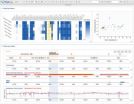(Press-News.org) An Australian–US team of climate researchers has solved a puzzle that has challenged scientists for over a decade. Climate models predict that the equatorial Pacific trades should weaken with increasing greenhouse gases. Yet, since the early 1990s, satellites and climate stations reveal a rapid and unprecedented strengthening of the Pacific trade winds, accelerating sea level rise in the western Pacific and impacting both Pacific and global climate.
"The answer to the puzzle is that recent rapid Atlantic Ocean warming has affected climate in the Pacific," say the scientists. Their findings from observations and modeling experiments are published in the August 3, 2014, online issue of Nature Climate Change.
"We were surprised to find that the main cause of the Pacific wind, temperature, and sea level trends over the past 20 years lies in the Atlantic Ocean," says Shayne McGregor at the University of New South Wales and lead author of the study. "We saw that the rapid Atlantic surface warming observed since the early 1990s, induced partly by greenhouse gasses, has generated unusually low sea level pressure over the tropical Atlantic. This, in turn, produces an upward motion of the overlying air parcels. These parcels move westward aloft and then sink again in the eastern equatorial Pacific, where their sinking creates a high pressure system. The resulting Atlantic–Pacific pressure difference strengthens the Pacific trade winds."
"Stronger trade winds in the equatorial Pacific also increase the upwelling of cold waters to the surface. The resulting near-surface cooling in the eastern Pacific amplifies the Atlantic–Pacific pressure seesaw, thus further intensifying the trade winds," says Axel Timmermann, corresponding author of the study at the University of Hawaii International Pacific Research Center. He comments further, "It turns out that the current generation of climate models underestimates the extent of the Atlantic–Pacific coupling, which means that they cannot properly capture the observed eastern Pacific cooling, which has contributed significantly to the leveling off, or the hiatus, in global warming."
In contrast to previous studies that explain the eastern Pacific cooling as resulting solely from natural climate variability, the international climate research team points to a climate feedback that has been overlooked, namely, that the recent Atlantic warming affects the atmospheric circulation over the Pacific, leading to an increased persistence of cold ocean conditions there.
"It will be difficult to predict when the Pacific cooling trend and its contribution to the global warming hiatus will come to an end. The natural variability of the Pacific, associated for instance with the El Niño-Southern Oscillation, is one candidate that could drive the system back to a more even Atlantic–Pacific warming situation," says co-author Matthew England from the University of New South Wales.
"Our study documents that some of the largest tropical and subtropical climate trends of the past 20 years are all linked: Strengthening of the Pacific trade winds, acceleration of sea level rise in the western Pacific, eastern Pacific surface cooling, the global warming hiatus, and even the massive droughts in California," explains co-author Malte Stuecker from the University of Hawaii Meteorology Department.
"We are just starting to grasp the scope of the impacts of this global atmospheric reorganization and of the out-of phase temperature trends in the Atlantic and Pacific regions," adds Fei-Fei Jin, climate scientist also at the University of Hawaii Meteorology Department.
INFORMATION:
Citation
Shayne McGregor, Axel Timmermann, Malte F. Stuecker, Matthew H. England, Mark Merrifield, Fei-Fei Jin, and Yoshimitsu Chikamoto: Recent Walker Circulation strengthening and Pacific cooling amplified by Atlantic warming. Nature Climate Change http://dx.doi.org/10.1038/nclimate2330.
Funding
Australian Research Council (ARC), including the ARC Centre of Excellence in Climate System Science. A.T. was supported through NSF grant No. 1049219. M.F.S. and F-F.J. were supported by US NSF grant ATM1034798, US Department of Energy grant DESC005110 and US NOAA grant NA10OAR4310200.
Author Contacts
Axel Timmermann, Professor of Oceanography, International Pacific Research Center, University of Hawaii at Manoa. Email: axel@hawaii.edu; Tel: (808) 956-2720.
Shayne McGregor, ARC DECRA, Climate Change Research Centre, University of New South Wales. Email: shayne.mcgregor@unsw.edu.au. Tel: within Australia 0449 151 210; from abroad 61 449 151 210.
IPRC Media Contact
Gisela Speidel, Outreach Specialist, International Pacific Research Center, University of Hawaii at Manoa. Email: gspeidel@hawaii.edu; Tel: (808)956-9252.
Atlantic origin of recent Pacific trade wind, sea level and temperature trends
2014-08-03
ELSE PRESS RELEASES FROM THIS DATE:
Self-assembling anti-cancer molecules created in minutes
2014-08-03
Researchers have developed a simple and versatile method for making artificial anti-cancer molecules that mimic the properties of one of the body's natural defence systems.
The chemists, led by Professor Peter Scott at the University of Warwick, UK, have been able to produce molecules that have a similar structure to peptides which are naturally produced in the body to fight cancer and infection.
Published in Nature Chemistry, the molecules produced in the research have proved effective against colon cancer cells in laboratory tests, in collaboration with Roger Phillips ...
Study finds new genetic risk markers in pancreatic cancer
2014-08-03
BOSTON –– A large DNA analysis of people with and without pancreatic cancer has identified several new genetic markers that signal increased risk of developing the highly lethal disease, report scientists from Dana-Farber Cancer Institute.
The markers are variations in the inherited DNA code at particular locations along chromosomes. Several of these variations in the DNA code were identified that influence an individual's risk for pancreatic cancer.
The discovery of these markers – along with four that were previously identified is important for several reasons, said ...
Rare developmental disorder linked to tumor-suppressing protein, Stanford researchers find
2014-08-03
CHARGE, which affects 1 in 10,000 babies, is an acronym whose letters stand for some of the more common symptoms of the condition: coloboma of the eye, heart defects, atresia of the choanae, retardation of growth and/or development, genital and/or urinary abnormalities, and ear abnormalities and deafness.
Originally, the researchers were examining the tumor-suppressive properties of the protein, called p53, not investigating developmental disorders. But when a mouse model developed a strange set of deficiencies, the researchers followed a trail of clues that led them ...
UMD researchers develop tool to better visualize, analyze human genomic data
2014-08-03
Scientists at the University of Maryland have developed a new, web-based tool that enables researchers to quickly and easily visualize and compare large amounts of genomic information resulting from high-throughput sequencing experiments. The free tool, called Epiviz, was described in a paper published online on August 3, 2014 in the journal Nature Methods.
Next-generation sequencing has revolutionized functional genomics. These techniques are key to understanding the molecular mechanisms underlying cell function in healthy and diseased individuals and the development ...
Making sense of scents
2014-08-03
For many animals, making sense of the clutter of sensory stimuli is often a matter or literal life or death.
Exactly how animals separate objects of interest, such as food sources or the scent of predators, from background information, however, remains largely unknown. Even the extent to which animals can make such distinctions, and how differences between scents might affect the process were largely a mystery – until now.
A new study, described in an August 3 paper in Nature Neuroscience, a team of researchers led by Venkatesh Murthy, Professor of Molecular and Cellular ...
Clues to curbing obesity found in neuronal 'sweet spot'
2014-08-02
New Haven, Conn. -- Preventing weight gain, obesity, and ultimately diabetes could be as simple as keeping a nuclear receptor from being activated in a small part of the brain, according to a new study by Yale School of Medicine researchers.
Published in the Aug. 1 issue of The Journal of Clinical Investigation (JCI), the study showed that when the researchers blocked the effects of the nuclear receptor PPARgamma in a small number of brain cells in mice, the animals ate less and became resistant to a high-fat diet.
“These animals ate fat and sugar, and did not gain ...
Pepper and halt: Spicy chemical may inhibit gut tumors
2014-08-02
Researchers at the University of California, San Diego School of Medicine report that dietary capsaicin – the active ingredient in chili peppers – produces chronic activation of a receptor on cells lining the intestines of mice, triggering a reaction that ultimately reduces the risk of colorectal tumors.
The findings are published in the August 1, 2014 issue of The Journal of Clinical Investigation.
The receptor or ion channel, called TRPV1, was originally discovered in sensory neurons, where it acts as a sentinel for heat, acidity and spicy chemicals in the environment. ...
Study reveals one reason brain tumors are more common in men
2014-08-02
New research at Washington University School of Medicine in St. Louis helps explain why brain tumors occur more often in males and frequently are more harmful than similar tumors in females. For example, glioblastomas, the most common malignant brain tumors, are diagnosed twice as often in males, who suffer greater cognitive impairments than females and do not survive as long.
The researchers found that retinoblastoma protein (RB), a protein known to reduce cancer risk, is significantly less active in male brain cells than in female brain cells.
The study appears Aug. ...
Understanding how neurons regulate metabolism in response to a high-fat diet
2014-08-02
The brain plays a central role in regulating appetite and whole-body metabolism. A protein known as PPARγ is important in the brain's control of food intake and body weight, but the identity of the neurons regulating this process has been unclear. A new study in the Journal of Clinical Investigation demonstrates that PPARγ activity in a type of neuron known as pro-opiomelanocortin (POMC) neurons is critical in mediating the response to high-fat diet. Sabrina Diano and colleagues at Yale University School of Medicine found that mice lacking PPARγ specifically ...
New research characterizes in-flight pediatric deaths
2014-08-01
CLEVELAND, Ohio – In a first-of-its-kind study, researchers at University Hospitals Rainbow Babies & Children's Hospital (UH Rainbow) found that lap infants may be at greater risk for death on a commercial airline flight. The study analyzed pediatric medical emergencies on flights worldwide between January 2010 and June 2013 and found 90 percent of deaths occurred in children under the age of 2.
The study was conducted in partnership with MedAire to characterize the rare event of an in-flight pediatric fatality onboard commercial airline flights worldwide. Through a ...





